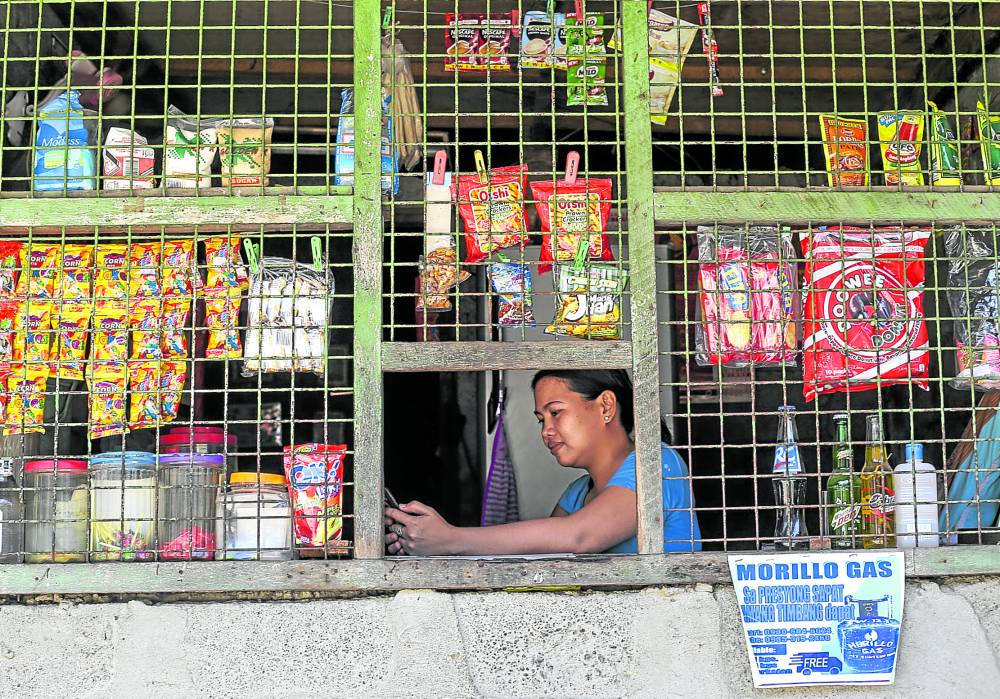Food inflation in ‘sari-sari’ stores higher at 15.62%

LOCAL BAROMETER In small neighborhood stores like this, the high inflation environment bites the hardest, according to findings of a data platform startup studying consumer behavior and spending patterns. —INQUIRER FILE PHOTO
“Sari-sari” stores in the country were not spared by the high inflation environment at the start of the year, with the prices of food items in these small neighborhood retail shops rising by almost a fifth last month, according to a study conducted by Philippine data platform startup Packworks.
Sari IQ, Packworks’ data analytics tool, which measures behavior and spending habits of consumers who buy in sari-sari stores, found a 15.62-percent average price increase across these goods, 4.4 percentage points higher than the food inflation rate cited in the same month by the Philippine Statistics Authority (PSA).
Of the food items in sari-sari stores, the vegetables, tubers, cooking bananas and pulses (or seeds such as beans, lentils and peas) category posted the highest inflation rate at 22.45 percent.
This was followed by ready-made food and other food products with 16.85 percent; milk, other dairy and eggs with 16.59 percent; oils and fats with 15.79 percent; sugar, confectionery and desserts with 15.30 percent, and cereals and cereal products with 10.85 percent.
The fruits and nuts category followed with 8.97 percent, and flour, bread, and other bakery products, pasta products, and other cereals was last at 7.14 percent.
Article continues after this advertisementThe sociocultural research firm Fourth Wall, which partnered with Packworks on the study, said the inflation rate in these stores where items are sold in “tingi” or small amounts could be indicative of the increasing pressure for owners to raise their markups and profit margins.
Article continues after this advertisementPoverty metric
It said these pressures come from continuing supply-side challenges, such as the shortage of eggs due to the spread of bird flu, and higher transportation costs due to expensive fuel.
“It is important for Filipino consumers to be aware of these discrepancies because the products (ready-to-eat food, eggs) whose inflation rate at the sari-sari store exceeds that of (inflation data released by the PSA) are also the ones that the lower class typically consume due to their association with convenience and cheap price,” said Fourth Wall research director John Brylle Bae.
“In a sociocultural context, we tend to measure how well-off or worse off we are through inflation—that is, inflation is the primary metric of poverty and economic performance, which becomes even more relevant if what is being discussed is food,” he added.
The research firm executive said this could be referenced to the often used phrase by older generations, “noong araw, mura pa ang… (In the old days, these goods were cheaper).”
Meanwhile, Packworks head of data Andres Montiel said that official statistics were limited in capturing grassroots patterns, indicating the necessity to cross-check these with data at the sari-sari store level to obtain a more precise understanding of micro-level dynamics.
Inflation in the Philippines went up further to 8.7 percent last January, faster than 8.1 percent in December 2022 that was earlier expected to have been the peak.
National Statistician Dennis Mapa said the January headline print was the fastest since 9.1 percent in November 2008 and was also almost thrice as fast as the 3 percent recorded in January 2022.
Price watch
The latest overall inflation was mainly driven by faster increases in housing rentals, electricity and water rates as well as in the prices of vegetables, milk and eggs, and fruits and nuts.
In a related development, the Metropolitan Manila Development Authority (MMDA) said it would work with Metro Manila mayors in monitoring the prices of basic goods sold in public markets.
MMDA acting Chair Romando Artes said local chief executives of the National Capital Region would be tapped to help ensure compliance with suggested retail prices (SRP) to “protect consumers from unscrupulous sellers.”
“We will coordinate with the Metro Manila Council (MMC) to conduct monitoring of prices in various wet markets in the metropolis,” Artes said during an inspection at Agora public market in San Juan City on Tuesday.
He led the inspection together with MMDA General Manager Procopio Lipana, San Juan City Mayor Francis Zamora and Assistant Trade Secretary Ann Claire Cabochan.
Two notices of violation were issued against retailers at Agora public market for selling imported onions higher than the SRP.
“Based on the latest price monitoring, the SRP of imported red onions is P125 per kilo, which covers medium and large-sized onions,” the MMDA said in a statement.
The inspection will not be done only in San Juan City, Artes said, as they were also planning to inspect all the markets throughout Metro Manila “so that we can monitor the price and to ensure that the price of the [monitored] product is correct.”
Zamora, who sits as president of the MMC, said the San Juan City government has established a local price coordinating council mandated to monitor the supply and prices of basic food items.
“I know that all mayors are very supportive of ensuring that the suggested retail prices in their markets are followed,” he said.